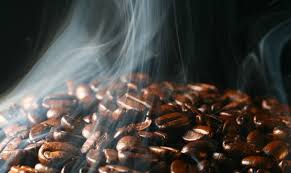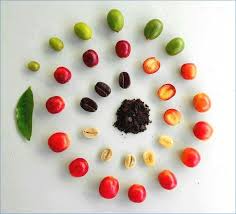
Roasting

-
Green Coffee Beans: Coffee beans are harvested from the coffee plant and processed to remove the outer layers, leaving behind green coffee beans. These green beans are dense and have a grassy aroma, lacking the flavors and aromas associated with roasted coffee.
-
Loading the Roaster: Green coffee beans are loaded into a coffee roasting machine, typically a drum roaster or air roaster. The roaster is preheated to the desired temperature, usually between 370°F to 540°F (188°C to 282°C), depending on the roasting profile and desired roast level.
-
Roasting Process: The roasting process begins as the green coffee beans are introduced into the heated roasting chamber. The beans undergo a series of chemical and physical changes as they roast, leading to the development of complex flavors and aromas.
-
Drying Phase: In the initial stage of roasting, known as the drying phase, the beans lose moisture and begin to turn yellow. They may emit a grassy smell as moisture evaporates from the beans.
-
First Crack: As the temperature of the beans increases, they undergo a process called pyrolysis, where sugars and amino acids react to produce the characteristic flavors of roasted coffee. This process also causes the beans to expand and release an audible cracking sound known as the first crack. At this point, the beans have reached a light roast level, with a bright acidity and pronounced origin flavors.
-
Development Phase: After the first crack, the beans continue to roast and undergo caramelization and Maillard reactions, which deepen the flavor profile and darken the color of the beans. Roasters carefully monitor the color and aroma of the beans to achieve the desired roast level, whether it's medium, medium-dark, or dark roast.
-
Cooling and Degassing: Once the desired roast level is reached, the roasted coffee beans are rapidly cooled to stop the roasting process and prevent over-roasting. The beans are then allowed to degas for a period of time to release excess carbon dioxide, which can negatively impact the flavor of freshly roasted coffee.
- Packaging and Storage: After degassing, the roasted coffee beans are packaged in airtight containers to preserve their freshness and flavor. Ideally, roasted coffee should be consumed within a few weeks to a month to enjoy its peak flavor.
2. Drum Roasting: This is a traditional method where coffee beans are roasted in a rotating drum over a heat source. The beans are agitated as they roast, ensuring an even roast.
3. Pan Roasting: Coffee beans can be roasted in a pan over a stove. This method requires constant stirring to prevent uneven roasting or burning.
4. Barbecue Roasting: Some enthusiasts roast coffee beans on a barbecue grill. This method requires careful temperature control and agitation to achieve an even roast.
5. Popcorn Popper Roasting: Using a hot air popcorn popper, coffee beans can be roasted at home. This method is affordable and popular among DIY enthusiasts.
6. Solar Roasting: Coffee beans can be roasted using solar energy. This method requires a solar roaster, which concentrates sunlight to roast the beans.
7. Hybrid Methods: Some roasters use a combination of techniques, such as combining air roasting with drum roasting, to achieve specific flavor profiles.
8. Custom Roasting Profiles: Professional roasters often develop custom roasting profiles for different coffee beans to bring out specific flavors and aromas. These profiles include variations in temperature, airflow, and roasting time.
9. Wood-Fired Roasting: Roasting coffee over an open flame or wood fire can impart unique smoky flavors to the beans.
10. Blending Roasts: Roasters can blend beans that have been roasted to different degrees to create complex flavor profiles.
- Roast Level: Coffee beans can be roasted to different levels, ranging from light to dark. Each roast level produces distinct flavor profiles, with lighter roasts typically retaining more of the beans' original flavors and darker roasts developing richer, more caramelized notes.
- Bean Varieties: Different coffee bean varieties, such as Arabica and Robusta, as well as specific cultivars within these species, have unique flavor profiles that can be accentuated through various roasting methods.
- Origin: The region where coffee beans are grown can significantly impact their flavor characteristics. Factors such as altitude, climate, soil composition, and processing methods all influence the beans' flavor profile and how they react to roasting.
- Processing Method: Coffee beans undergo various processing methods after harvesting, such as washed, natural, or honey processing. These methods can affect the beans' moisture content and flavor profile, influencing how they roast.
- Roasting Equipment: The type of roasting equipment used, such as commercial roasters, home roasters, or even improvised methods like using a cast-iron skillet, can affect the roasting process and the resulting flavor profile.
- Roasting Time and Temperature: Adjusting the roasting time and temperature allows roasters to control the development of flavors and aromas in the coffee beans. Small changes in these parameters can lead to significant variations in the final cup.
- Cooling Process: How the beans are cooled after roasting can also impact their flavor. Rapid cooling helps preserve delicate flavors and prevent over-roasting.
- Resting Period: After roasting, coffee beans typically undergo a resting period to allow for degassing and flavor development. The duration of this resting period can influence the flavor profile of the coffee.
By experimenting with these factors and techniques, coffee roasters can create an extensive range of flavor profiles, making coffee roasting a deeply nuanced and creative process.Each of these methods offers a unique approach to roasting coffee, allowing roasters to experiment and discover new flavor profiles.The roasting process is a delicate balance of time, temperature, and airflow, with skilled roasters using their expertise to craft coffees with unique flavor profiles and characteristics.




